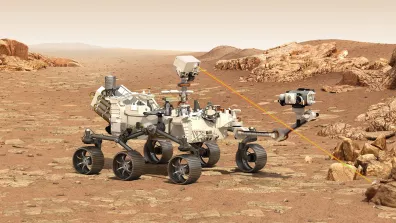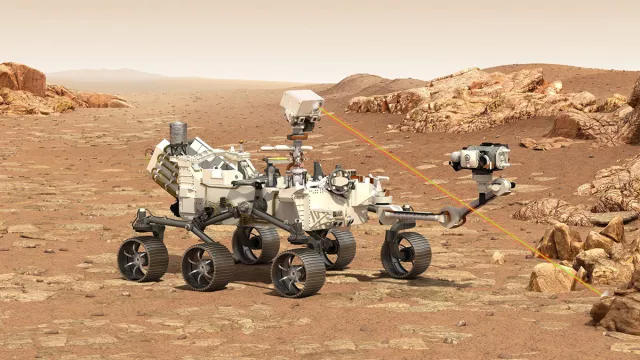Mars 2020 is a space mission to explore Mars developed by NASA. The centrepiece of the mission is its rover, named Perseverance, which landed on the surface of the red planet on 18 February 2021.
Key information
| Mission | Study the geologic diversity of Mars to seek signs of ancient life. Cache, seal and store samples for return to Earth by later missions. |
|---|---|
| Domain | Science |
| Launch date | 30 July 2020 |
| Partners | CNRS, NASA, JPL, LANL, University of Valladolid (Spain) |
| Where | Mars, Jezero Crater (ancient lakebed and delta) |
| Lifetime | 1½ Mars years (about 1,000 Earth days) |
| Status | In operation |
Key figures
- 7 instruments on rover
- 9 cameras on rover
- 3 x 2.7 x 2.2 m: rover dimensions
- 1,050 kg: rover mass
Key milestones
- 25 January 2024: End of Ingenuity’s mission after 72 flights
- 19 April 2021: First flight of Ingenuity
- 3 April 2021: Ingenuity helicopter deployed on surface of Mars
- 18 February 2021: Perseverance rover lands on Mars
- 30 July 2020: Mars 2020 mission launched by Atlas V 541
- November 2018: Jezero Crater selected as landing site
- July 2014: Instruments selected by NASA
- 4 December 2012: NASA announces start of development of Mars 2020 Perseverance mission
Project in brief
Launched on 30 July 2020 from Cape Canaveral, Perseverance landed on 18 February 2021 in Jezero Crater, an impact basin 45 kilometres wide chosen for its geologic diversity and the site of an ancient river delta that flowed into a lake three and a half billion years ago. This lake-delta system offers the prospect of collecting samples from a great variety of rocks and minerals, particularly carbonates that could potentially hold fossil traces of past life.
SuperCam is one of the seven scientific instruments on the Perseverance rover. It is in fact a suite of instruments employing five different measuring technologies. This suite comprises three spectrometers (LIBS, Raman and infrared), a camera and a microphone. SuperCam is an enhanced version of the ChemCam instrument on NASA’s Curiosity rover operating on Mars since 2012.
Like ChemCam, SuperCam is able to analyse the chemical composition of rocks by firing a laser at them, a technique called laser-induced breakdown spectroscopy or LIBS. It is also able to detect rocks’ minerals composition—i.e. how atoms are arranged into molecules and how molecules are bound together—and any organic molecules by Raman and infrared spectrometry. The laser investigates rocks from a distance of seven metres and the Raman spectrometer and camera from 12 metres. SuperCam is thus able to analyse targets remotely.
The colour camera—as opposed to the black-and-white camera on ChemCam—images rocks targeted for spectrometric analysis to provide context. The microphone serves to determine certain characteristics of rocks, for example hardness and porosity, by measuring the noise of laser impacts. It is also used to analyse the planet’s atmosphere.
SuperCam is the result of close collaboration between the U.S. Los Alamos National Laboratory (LANL) and the IRAP astrophysics and planetology research institute (France), with a contribution from the University of Valladolid (Spain). Design and construction of the French contribution to SuperCam, called the Mast Unit, was initiated and coordinated by IRAP with CNES oversight. Other French laboratories— the Midi-Pyrenees Observatory (OMP), the LAB astrophysics laboratory in Bordeaux, the LESIA space and astrophysics instrumentation research laboratory and the LATMOS atmospheres, environments and space observations laboratory—also contributed elements of the instrument. The flight model of SuperCam was delivered to LANL in June 2019. Another model of the instrument, called the Test Bed Unit, is currently on the Optimism rover (Operational Perseverance Twin for Integration of Mechanisms and Instruments Sent to Mars) operated at JPL’s Mars Yard, used to plan Perseverance operations.
Perseverance is also collecting and caching samples of Martian rock inside hermetically sealed vessels for later recovery by NASA/ESA Mars Sample Return (MSR) missions and their return to Earth. SuperCam is crucial for selecting sampling sites. Samples will subsequently be analysed on Earth to look for traces of active, dormant or past life. Perseverance was assisted in its search for samples by the first Martian helicopter, Ingenuity.
The mission applies COSPAR planetary protection recommendations. Before departure, Perseverance was biologically decontaminated to preserve the biological conditions on Mars and avoid false positives when analysing samples. These samples will be returned to Earth following strict confinement and sterilization procedures to avert any biological threat to Earth’s biosphere.
CNES’s role
CNES was in charge of designing and building the French component of SuperCam.
Contacts
Perseverance/SuperCam Project Leader
Magali Bouyssou
E-mail: magali.bouyssou at cnes.fr
Exobiology, Exoplanets and Planetary Protection subject matter expert
Christian Mustin
E-mail: christian.mustin at cnes.fr
Project news



